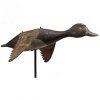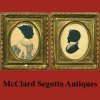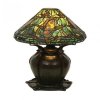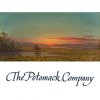Shaker Sale
June 4th, 2016
Skinner, Inc., Marlborough, Massachusetts
Quiet but dedicated Massachusetts conservationist and philanthropist Erhart Rudolph Muller (1909-2015) and his wife, Ruth Tate Atwood Muller, began collecting Shaker art and artifacts in the 1940s. Ruth, who had arrived in the 1940s at Harvard, Massachusetts, as a librarian and married Erhart, died at 97 in 2006. The Mullers’ collection came to market at Skinner’s June 4 auction at the Marlborough, Massachusetts, gallery with first-rate material that drew bidders who were pleased at the opportunity to buy. The Muller collection represents probably the last collection acquired directly from the Shakers. It was wide and well cared for; the Mullers were careful stewards. Skinner sold a group of the Mullers’ Shaker antiques some 20 years ago.The first 150 lots of this sale were from the Muller collection; another 135 lots came from various collections, including that of Suzanne Courcier and Robert W. Wilkins.
 A 19th-century painted schoolroom alphabet in exquisite penmanship on two long boards enclosed in a blue-painted frame, 20½" x 159½", with uppercase letters on the top and lowercase letters, numerals, and punctuation on the bottom, was the runaway dazzler. Each letter was perfection. Estimated at $15,000/25,000, it sold on the phone for $104,550 (includes buyer’s premium).
A 19th-century painted schoolroom alphabet in exquisite penmanship on two long boards enclosed in a blue-painted frame, 20½" x 159½", with uppercase letters on the top and lowercase letters, numerals, and punctuation on the bottom, was the runaway dazzler. Each letter was perfection. Estimated at $15,000/25,000, it sold on the phone for $104,550 (includes buyer’s premium).

This 19th-century schoolroom alphabet, made when penmanship was an art, was the runaway star of the auction. Estimated at $15,000/25,000, the board sold to the trade for $104,550.
In 1941 when Erhart Muller acquired the former carpenter’s shop at the Harvard Shaker plot for his own home, the alphabet board was already in the house. It most likely came from the Harvard, Massachusetts, community schoolhouse, which had been moved to opposite the cemetery. Catalog notes tell us that children in Shaker communities were educated by adult believers, the boys in the winter and the girls in the summer, in four-month terms. The board was on view in 1988 at the Fruitlands Museum in Harvard and again in 2014, also at Fruitlands. The board also inspired a lively discussion during the preview of the lost art of penmanship.
The successful bidder, Robert W. Wilkins of Yarmouth Port, Massachusetts, is a major Shaker dealer and authority. His partner was Suzanne Courcier (1948-2015). They had made a decision early on not to compete with their clients. Wilkins said he determines “how good something is based on the intensity of the ping” of regret when he sells it. One can only imagine the resonance of the ping when he parts with the alphabet board.
A maple sewing desk in red stain, circa 1830, with six drawers (two sets of three over three) in the stepback case, three on the front and three more on the side, all with mahogany pulls, pine secondary wood, and a pine slide with white porcelain pulls, sold to an unidentified representative of an institution in the gallery for $67,650 (est. $20,000/30,000). The desk was pristine, with only moderate signs of use. Muller purchased the desk at the Shaker community at Sabbathday Lake, Maine, a transaction in the 1960s that was facilitated by Eldress Emma King of the Canterbury community.

The Mullers acquired this red-stained maple sewing desk, circa 1830, with a pine slide and secondary wood at Sabbathday Lake, Maine, in the 1960s through the efforts of Eldress Emma King of Canterbury. It was immaculate and brought $67,650. Skinner photo.
An Enfield, New Hampshire, one-drawer table was dovetailed and made with a tiger maple top and bird’s-eye maple legs, a cherry drawer front with a maple knob, and birch sides. The drawer bottom was inscribed in pencil, “Infirmary 1917.” It was on view at the 1988 exhibit at the Fruitlands Museum in Harvard, Massachusetts. The table sold for $52,275 (est. $20,000/30,000). Another single-drawer table in red stain came from the Canterbury Shaker community and was made around 1830 in maple with pine on the sides of the drawer. Its slightly splayed legs transition gracefully from square to round, and the two-board top has breadboard ends. It brought $14,760 (est. $20,000/30,000).

This Canterbury oval carrier with a fixed handle and three fingers was made around 1860 in maple and pine with a bittersweet-stained exterior and an interior in yellow stain. It is inscribed neatly on the bottom “Ednah E. Fitts, Chh. Canterbury 1860.” Fitts was a trustee and nurse at Canterbury and was also the assistant ministry eldress. The carrier sold for $14,760 (est. $30,000/50,000). It had been on view in 1986 at the Whitney Museum of American Art. Skinner photo.
The Mullers collected fine boxes and carriers that were swept up by bidders. A pine and maple covered oval box in olive-green paint was made around 1881 at the Mount Lebanon, New York, community. With four fingers and the inscription “Presented to / Amelia Joslin / March 29, 1881 / by Sister Dana Brewster,” it sold for $18,450. The top of the lid was painted in red “I.D.,” probably for James Daniels. Dana Brewster was a ministry eldress at the Shaker community at Hancock, Massachusetts. Daniels was at the Enfield, Canterbury, Hancock, and Harvard communities.
Another auctioneer’s favorite was a small, 1 7/8" x 2 7/8", maple and pine circular gift box in red paint that was likely made around 1850 by Elder Joseph Johnson of the Canterbury community. A paper label with the name “Jane” was attached to the bottom, and the box brought $11,070 (est. $4000/6000).

This dovetailed bird’s-eye maple sewing box with a diamond-shaped bone escutcheon and two dovetailed interior trays, one with 12 chrome spools on steel shafts, the other with buttons and other sewing implements, realized $4920 (est. $2000/3000). Skinner photo.
A 19th-century Canterbury or Enfield pail in chrome-yellow paint with a white-painted interior showed some use but had been treated kindly. A major dealer was pleased to get it for $1107.
Furniture and accessories from other collections more than held their own. A rare early 19th-century figured maple candlestand in red stain came from a collector who owned it for at least 35 years. It sold to another collector for $86,100 (est. $6000/8000). It was made with a circular top on a turned platform and a turned and tapering post on three arched legs. Its condition was superb, and catalog notes referred only to a shrinkage crack on the top and an old dutchman repair to the underside. Similar examples have surfaced in the past, one of which is on view at the American Museum in Bath, England. A Canterbury pine door-over-door cupboard, circa 1830, that brought $7380 came from the collection of Suzanne Courcier and Robert W. Wilkins.
For more information, check the website (www.skinnerinc.com) or call (508) 970-3200.

This 11-drawer pine chest, 73" x 51½" x 26¼", made around 1830, retains the original red wash, maple pulls, and thumbnail-molded drawer fronts and the inscription “Grove” on the bottom of the fourth drawer. Each drawer is numbered, beginning with number 1 on the bottom. It fetched $22,140. The chest was found in the attic of the dwelling house at the Canterbury community.

This five-drawer chest, 54½" x 44½" x 22¼", that was thought to have been made by Daniel Sering at the Union Village community in Turtle Creek Township in Warren County, Ohio, around 1850 sold for $11,685 (est. $2000/3000). It is made with a black walnut case and drawer fronts with fruitwood pulls, poplar secondary wood, and an overhanging top. The drawers are numbered in red chalk on the backs.

This birch and pine counter from the Enfield, New Hampshire, community was made around 1830 with an unusual configuration of cupboard doors and open shelving. From the collection of Suzanne Courcier and Robert W. Wilkins, it sold after the auction for $17,220. Skinner photo.

From the highly regarded collection of Suzanne Courcier and Robert W. Wilkins, this 1834 pine tall-case clock with 30-hour wooden works, 77½" x 13¾" x 8½", is signed and dated by the maker, Isaac Newton Youngs of the New Lebanon, New York, community. It brought $24,600. Skinner photo.

This circa 1850 bittersweet/red-painted maple and pine gift box, possibly the work of Elder Joseph Johnson of Canterbury, New Hampshire, has a paper label reading “Jane” in Gothic lettering on the bottom and is 1 7/8" high with a 2" diameter. Estimated at $4000/6000, it sold for $11,070 to Woodbury, Connecticut, dealer David Schorsch for inventory. “This was one of the nicer pieces in the sale,” said Schorsch.
Originally published in the August 2016 issue of Maine Antique Digest. © 2016 Maine Antique Digest





















































